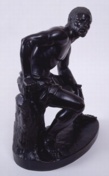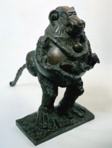

Abbreviated as br.
When a bronze decoration is gilt it is often called ormolu.
Many of the alloys that are described as bronze are actually brass, which is the alloy of copper and zinc. Alloys with both zinc and tin are known as gunmetals.
Examples of works in bronze:
Greece, from Olympia, Statuette of a Horse, Geometric Period, c. 750-700 BCE, bronze, Michael C. Carlos Museum, Emory U, Atlanta, GA. Such bronze statuettes were most often dedicated in sanctuaries as votive offerings. A figurine much like this one appeared in the movie "Black Stallion," and was called Bucephalus.
![]()
Greek, Crete, 690-670 BCE,
Lyre Player, bronze, height
4 1/2 inches (11.5 cm), J. Paul Getty Museum, Malibu, CA.

Etruria, Chariot, c. 550-525 BCE,
bronze, ivory,
height 51 9/16 inches (130.91
cm), Metropolitan Museum of Art, NY. See Etruscan art and repoussé.

Russia, Krasnodar Region, Kuban area, Seven
Brothers burial mound, Bridle Plaque in the Form of a Resting Stag,
mid 5th century BCE,
bronze, 4.7 x 4.7 cm, Hermitage Museum, St. Petersburg, Russia.
See plaque and Russian
art.
![]()
Greek, late fourth century BCE,
Statue of a Victorious Youth, bronze
with copper inlays,
height 59 5/8 inches (151.5
cm), J. Paul Getty Museum, Malibu, CA. See nude.
Thailand, Dvaravati, 8th - 9th century, Buddha Shakyamuni, bronze with lacquer and gilding, 6 1/2 x 3 5/8 x 1 3/4 inches (16.5 x 9.2 x 4.4 cm), Los Angeles County Museum of Art.

Southern Netherlands or Eastern France (Lorraine),
Aquamanile: Aristotle Ridden by Phyllis,
c. 1400, bronze, height
13 1/4 inches (33.5 cm), Metropolitan Museum of Art, NY. See
aquamanile and Dutch
art.
England, fifteenth century, Book Clasp. This was found in England early in 1998 along the River Thames foreshore (river bank area concealed at high tide, but revealed at low), length 5.8 cm, width 3.3 cm, Michael Delahunt collection.
Jean Houdon (French, 1741-1828).
Antoine Louis Barye (French, 1796-1875). See animalia.

Jean-Jacques Feuchère (French, 1807-1852),
Satan, c. 1836, bronze, height
31 inches (78.7 cm), Los Angeles County Museum of Art.

John Quincy Adams Ward (American, 1830-1910), The Freedman, 1862,
bronze, 20 x 14 3/4 x 7 inches, National Academy of Design, NY.
Auguste Rodin (French, 1840-1917), She Who Was the Helmet-Maker's Beautiful Wife, c. 1880-85, bronze, height 19 1/2 inches (49.5 cm), Los Angeles County Museum of Art. See Realism.

Augustus Saint-Gaudens (American, 1848-1907),
The Puritan, 1883-1886 (this cast, 1899
or after), bronze, 30 1/2 x 18 1/2 x 13 inches (77.5 x 47 x 33
cm), Metropolitan Museum of Art, NY. See American
Colonial art, the period this sculpture depicts.
Aristide Maillol (French, 1861-1944)

Henri Matisse (French, 1869-1954), Henriette III (Large Head), 1929, bronze, height
40 cm, Hermitage Museum, St. Petersburg, Russia.

Pablo Picasso (Spanish, 1881-1973), Cock, 1932, bronze, 65.1 x 54.3 x 31.8
cm, Tate Gallery, London.

Pablo Picasso, Baboon and Young, 1951, bronze,
height 21 inches.
Henry Moore (English, 1898-1987)
Joel Shapiro (American, 1941-).
Deborah Butterfield (American, 1949-).
Also see copyright, core, crown, direct casting, fibula, indirect casting, lead, lost-wax casting, mirror, mold, patina, statue, and temperature.
https://inform.quest/_art
Copyright © 1996-![]()